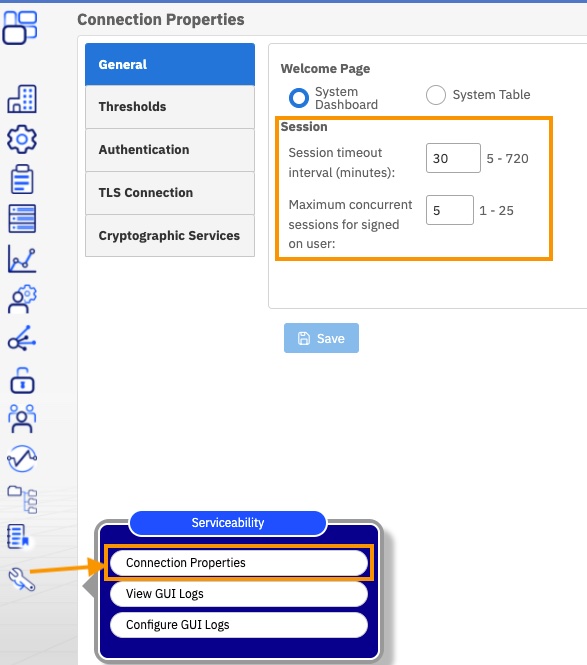How To
Summary
Set your maximum concurrent sessions and learn how best to open multiple Navigator pages.
Objective
You are in: IBM i Technology Updates > Navigator for i > Documentation on Functional Areas > Multitasking with new Navigator
Topics on this page:
- Active Sessions Setting
- Preferred: Copy-and-paste method
- Not recommended: Using login screen to sign in to multiple windows
Active Sessions Setting
The "Maximum concurrent sessions for signed-on user" setting allows a user to have more than one browser session open to view multiple Navigator sessions at the same time. It also provides a limit to the number of sessions to prevent one user from continually opening new sessions in a destructive manner.
The max concurrent sessions setting limits the total active HTTP sessions for one user. So a single user cannot keep logging in to Navigator.
Go to Serviceability > Connection Properties. On the General tab, the Session section allows a user to set two properties:
- Session timeout interval (in minutes)
- Maximum concurrent sessions for signed-on user (max 25)

The setting of "Maximum concurrent sessions for signed-on user" limits the number of active sessions that can exist at the same time for each user. When another session beyond the set limit is started (given a valid user and password is provided), the user can log in successfully. However, the oldest idle or inactive session (one of the previously opened active sessions) is logged out to keep the number of sessions within the limit. The session selected to be signed out is the one with the max inactive interval (without any user operations).
- Tabs and windows for the same browser share the session seed, so are not included in the session count.
- Separate connections are included in the session count. A separate connection is another browser, or another PC connection with the same browser.
- Using the cut-and-paste method for opening multiple Navigator tabs, allows multiple pages to be open without additional sessions.
One way to use multiple windows and tabs is to copy the URL directly and paste that URL to another window or tab. Then, click Enter to launch that page. The Navigator page from the URL opens directly on the new window or tab.
Copy-and-paste method
On one browser window, copy the URL for your signed-in session, and paste it to another tab in this same browser window. Using the copy-and-paste method brings you directly to the same page as the copied page. Different tabs and windows for one browser share the HTTP session.
Opening multiple windows and tabs for the same browser, with the copy-and-paste URL method, doesn't increase the active session count for the user. With the copy-and-paste URL method, each window or tab shares the HTTP session with the original.
Using login screen to sign in to multiple windows
Using a new login screen to sign in to multiple windows or tabs on the same browser, causes all signed-in sessions on that same browser window to be disconnected. Logging in with the login screen causes a new HTTP session seed, which overwrites the session seed for previous logins.
Each time you sign in through the navigator login page, the new login disables the old windows and tabs. A new HTTP session seed is created and causes other sessions to get logged out.
Document Location
Worldwide
[{"Type":"MASTER","Line of Business":{"code":"LOB57","label":"Power"},"Business Unit":{"code":"BU058","label":"IBM Infrastructure w\/TPS"},"Product":{"code":"SWG60","label":"IBM i"},"ARM Category":[{"code":"a8m0z0000000CH1AAM","label":"IBM Navigator for i"}],"ARM Case Number":"","Platform":[{"code":"PF012","label":"IBM i"}],"Version":"7.3.0;7.4.0;and future releases"}]
Was this topic helpful?
Document Information
Modified date:
01 March 2022
UID
ibm16558544